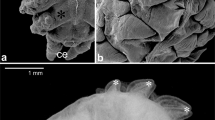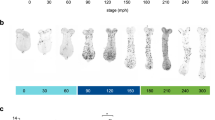Abstract
SINCE 1946 imaginal disks of Drosophila have been subjects for experimental morphogenesis3 because of their morphological discreteness, the long period they remain undifferentiated in the larva, and the ease of operation and transplantation. All the adult epidermal structures of cyclorrhaphous Diptera are thought to derive from imaginal disks: head structures from labial, antennal, and eye disks; limbs, wings, and general thoracic epidermis from thoracic disks; genital apparatus from genital disks; and the abdominal epidermis from abdominal “imaginal disks”4 which, however, have been ignored because they differ from other imaginal disks. The adult cells of disks are set apart from the larval epidermis during embryonic development. Earlier workers have suggested a larval5 and prepupal6 origin of the abdominal “disks” in other species. Bautz7, in a study of the larval abdominal epidermis of Calliphora, shows that the “disks” are probably present from the time of hatching also. I have examined the abdominal epidermis of Calliphora erythrocephala throughout larval life, in whole mounts and in sectioned material by light and electron microscopy. Observations on the abdominal histoblasts show they should no longer be referred to as “imaginal disks”, because the abdominal histoblasts differ not only in morphology but also in ultrastructural differentiation and developmental behaviour.
This is a preview of subscription content, access via your institution
Access options
Subscribe to this journal
Receive 51 print issues and online access
$199.00 per year
only $3.90 per issue
Buy this article
- Purchase on Springer Link
- Instant access to full article PDF
Prices may be subject to local taxes which are calculated during checkout
Similar content being viewed by others
References
Hadorn, E., and Gloor, H., Rev. Suisse Zool., 53, 495 (1946).
Hadorn, E., Bertani, G., and Gallera, J., Wilhelm Roux Arch. EntwMech. Org., 144, 31 (1949).
Ephrussi, B., and Beadle, G. W., Amer. Natur., 70, 218 (1936).
Nöthiger, R., and Gehring, W., in Developmental Systems—Insects (edit. by Counce, S. J.) (Academic Press, London and New York, in the press).
Robertson, C. W., J. Morphol., 59, 351 (1936).
Anderson, D. T., J. Embryol. Exp. Morph., 12, 65 (1964).
Bautz, A. M., Archs. Zool. Exp. Gén., 112, 157 (1971).
Emmert, W., Wilhelm Roux Arch. EntwMech. Org., 169, 87 (1972).
Garcia-Bellido, A., and Merriam, J. R., Dev. Biol., 26, 264 (1971).
Ursprung, H., and Schabtach, E., Wilhelm Roux Arch. EntwMech. Org., 160, 243 (1968).
Wigglesworth, V. B., The Control of Growth and Form: a Study of the Epidermal Cell of an Insect (Cornell, New York, 1959).
Murray, F. V., and Tiegs, O. W., Q. J. Microsc. Sci., 77, 405 (1935).
Piepho, H., Biol. Zbl., 58, 356 (1938).
Author information
Authors and Affiliations
Rights and permissions
About this article
Cite this article
PEARSON, M. Imaginal Disks and the Abdominal Histoblasts of Calliphora erythrocephala (Diptera). Nature 238, 349–351 (1972). https://doi.org/10.1038/238349a0
Received:
Revised:
Issue Date:
DOI: https://doi.org/10.1038/238349a0
This article is cited by
-
Regulation and metamorphosis of the abdominal histoblasts ofDrosophila melanogaster
Wilhelm Roux's Archives of Developmental Biology (1979)
-
Histological analysis of the dynamics of growth of imaginal discs and histoblast nests during the larval development ofDrosophila melanogaster
Wilhelm Roux's Archives of Developmental Biology (1977)
-
Autonomous and non-autonomous cell death in the metamorphosis of the epidermis ofDrosophila
Wilhelm Roux's Archives of Developmental Biology (1975)
-
The ultrastructure of the developing leg disk of Calliphora erythrocephala
Zeitschrift f�r Zellforschung und mikroskopische Anatomie (1974)
Comments
By submitting a comment you agree to abide by our Terms and Community Guidelines. If you find something abusive or that does not comply with our terms or guidelines please flag it as inappropriate.



